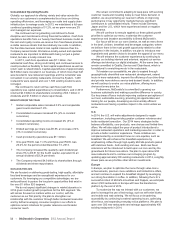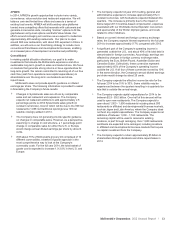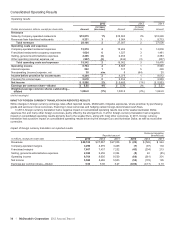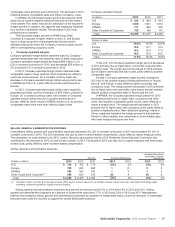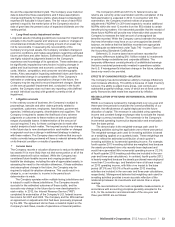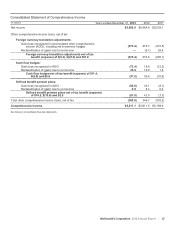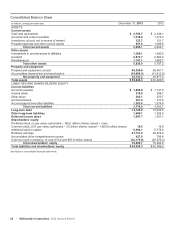McDonalds 2013 Annual Report Download - page 28
Download and view the complete annual report
Please find page 28 of the 2013 McDonalds annual report below. You can navigate through the pages in the report by either clicking on the pages listed below, or by using the keyword search tool below to find specific information within the annual report.
20 | McDonald’s Corporation 2013 Annual Report
Capital expenditures decreased $224 million or 7% in 2013,
primarily due to lower reinvestment in existing restaurants, partly
offset by higher investment in new restaurants. Capital
expenditures increased $319 million or 12% in 2012, primarily due
to higher reinvestment in existing restaurants and higher
investment in new restaurants. In 2013, the lower reinvestment
primarily reflected fewer planned reimages. In both years, the
increase related to new restaurants reflected our commitment to
broaden accessibility to our brand.
Capital expenditures invested in major markets, excluding
Japan, represented over 70% of the total in 2013, 2012 and 2011.
Japan is accounted for under the equity method, and accordingly
its capital expenditures are not included in consolidated amounts.
Capital expenditures
In millions 2013 2012 2011
New restaurants $ 1,473 $ 1,340 $ 1,193
Existing restaurants 1,244 1,615 1,432
Other(1) 108 94 105
Total capital expenditures $ 2,825 $ 3,049 $ 2,730
Total assets $36,626 $35,386 $32,990
(1) Primarily corporate equipment and other office-related expenditures.
New restaurant investments in all years were concentrated in
markets with strong returns or opportunities for long-term growth.
Average development costs vary widely by market depending on
the types of restaurants built and the real estate and construction
costs within each market. These costs, which include land,
buildings and equipment, are managed through the use of
optimally-sized restaurants, construction and design efficiencies,
and leveraging best practices. Although the Company is not
responsible for all costs for every restaurant opened, total
development costs (consisting of land, buildings and equipment)
for new traditional McDonald’s restaurants in the U.S. averaged
approximately $3.0 million in 2013.
The Company owned approximately 45% of the land and
about 70% of the buildings for restaurants in its consolidated
markets at year-end 2013 and 2012.
SHARE REPURCHASES AND DIVIDENDS
For the last three years, the Company returned a total of $16.4
billion to shareholders through a combination of share
repurchases and dividends.
Shares repurchased and dividends
In millions, except per share data 2013 2012 2011
Number of shares repurchased 18.7 28.1 41.9
Shares outstanding at year end 990 1,003 1,021
Dividends declared per share $ 3.12 $ 2.87 $ 2.53
Treasury stock purchases (in
Shareholders' equity) $ 1,810 $2,605 $3,373
Dividends paid 3,115 2,897 2,610
Total returned to shareholders $ 4,925 $5,502 $5,983
The Company’s Board of Directors approved a share
repurchase program, effective August 1, 2012, that authorizes the
purchase of up to $10 billion of the Company's outstanding
common stock with no specified expiration date. In 2013,
approximately 18.7 million shares were repurchased for $1.8
billion, bringing the total purchases under the program to $2.6
billion.
The Company has paid dividends on its common stock for 38
consecutive years and has increased the dividend amount every
year. The 2013 full year dividend of $3.12 per share reflects the
quarterly dividend paid for each of the first three quarters of $0.77
per share, with an increase to $0.81 per share paid in the fourth
quarter. This 5% increase in the quarterly dividend equates to a
$3.24 per share annual dividend and reflects the Company’s
confidence in the ongoing strength and reliability of its cash flow.
As in the past, future dividend amounts will be considered after
reviewing profitability expectations and financing needs, and will
be declared at the discretion of the Company’s Board of Directors.
Financial Position and Capital Resources
TOTAL ASSETS AND RETURNS
Total assets increased $1.2 billion or 4% in 2013. Excluding the
effect of changes in foreign currency exchange rates, total assets
increased $1.5 billion in 2013. Approximately 80% of total assets
were in major markets at year-end 2013. Net property and
equipment increased $1.1 billion in 2013, primarily due to capital
expenditures, partly offset by depreciation, and represented about
70% of total assets at year end.
Operating income is used to compute return on average
assets, while net income is used to calculate return on average
common equity. Month-end balances are used to compute both
average assets and average common equity.
Returns on assets and equity
2013 2012 2011
Return on average assets 24.8% 25.4% 26.0%
Return on average common
equity 35.8 37.5 37.7
In 2013, return on average assets and return on average
common equity decreased, reflecting lower growth in operating
results. In 2012, return on average assets and return on average
common equity decreased due to the negative impact of foreign
currency translation primarily on operating income and net
income. Operating income does not include interest income;
however, cash balances are included in average assets. The
inclusion of cash balances in average assets reduced return on
average assets by about two percentage points for all years
presented.




